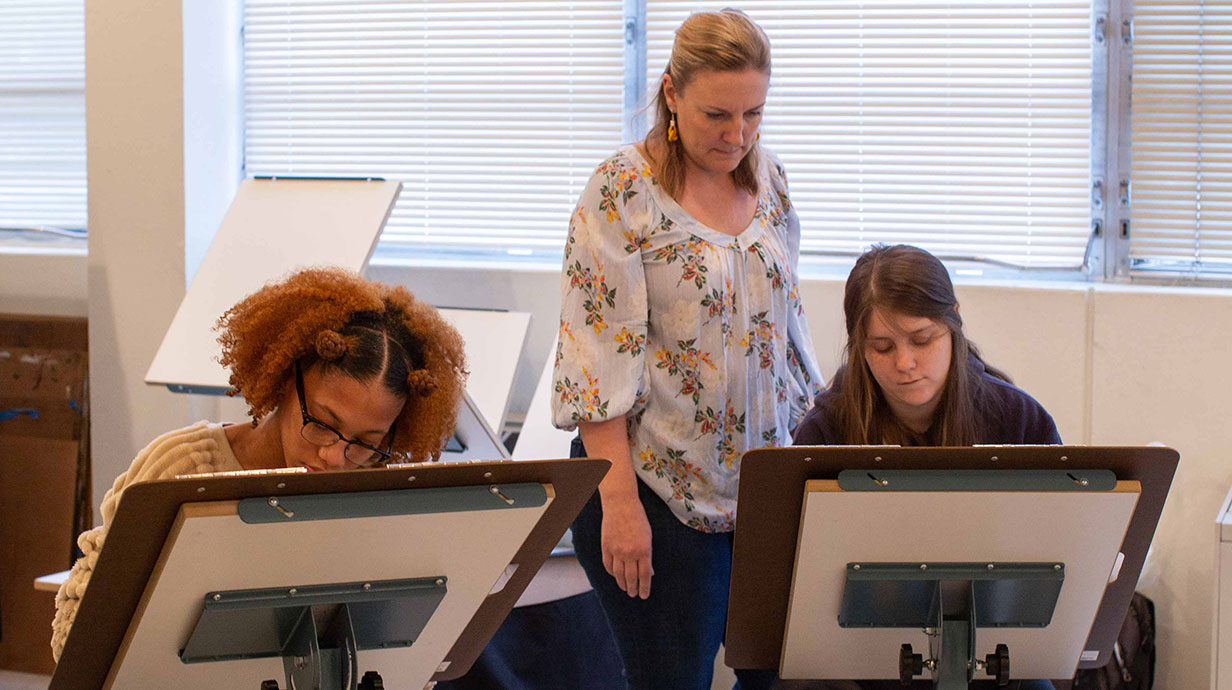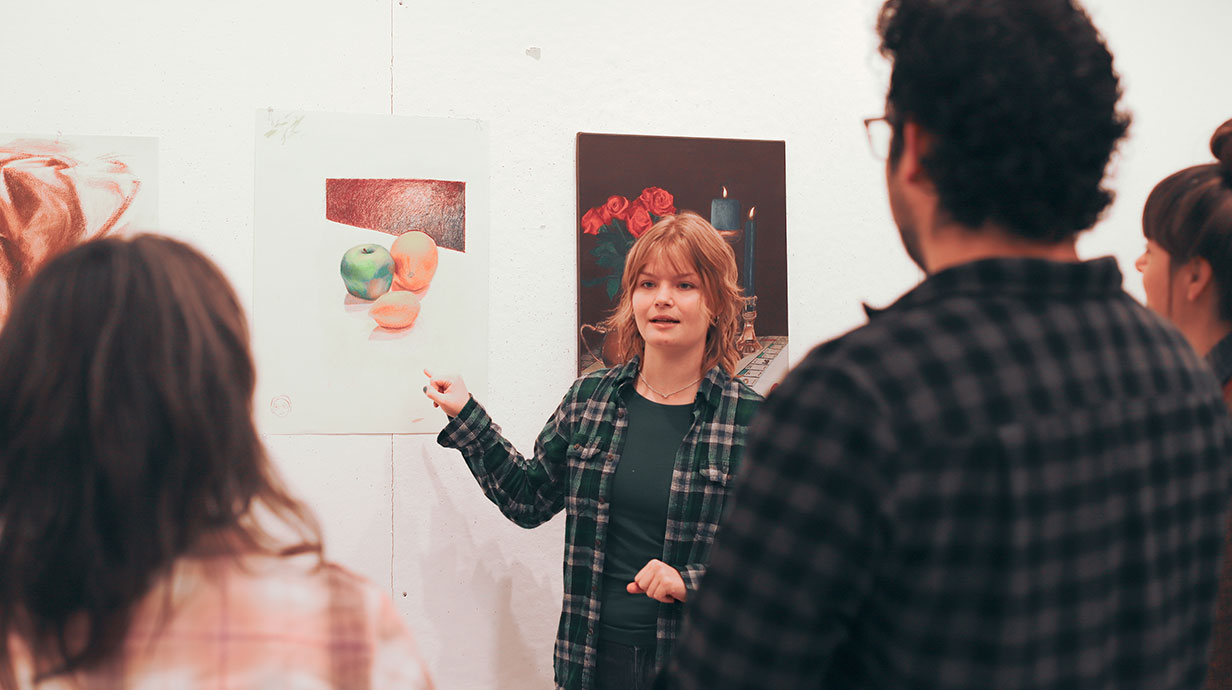Prospective Student for Art & Art History
When you enter the Department of Art and Art History, you are truly beginning a life immersed in a community dedicated to visual art.

Build Your Future in Art and Art History
To be a studio artist, you will need a strong foundation in techniques, processes, and critical thought, an environment that supports creativity and learning, mentors, role models, & friends, as well as well-equipped studios. To be an art historian, you will need to examine works of art in their historical, social, and political contexts, conduct research, discern the ideas conveyed by art, and learn the basic methods and techniques used to produce visual art.
This is exactly what the Department of Art and Art History at the University of Mississippi provides. Our faculty are all working artists and art historians who have achieved success and distinction in their careers. They invest in every student, guiding and instructing them in small classes with individualized attention. We believe that every student with a love of art should have the opportunity to develop their skills and explore their talents. We welcome anyone with this passion to learn more about our three undergraduate degrees in studio art and art history.
Welcome From The Recruitment Committee Chair
 I often receive questions about the difference between the B.A. and B.F.A. in Art degrees. Both start with the same art skills foundation yet offer two different experiences.
I often receive questions about the difference between the B.A. and B.F.A. in Art degrees. Both start with the same art skills foundation yet offer two different experiences.
The B.A. degree has a deeper and wider general education foundation than the B.F.A. degree and provides flexibility for combining with a required minor, such as Art History, Business, Marketing, Professional Writing, Southern Studies, and more. BA students use their art electives to focus on the studio area of their choice or sample across studios. As a broad, flexible degree within the context of the liberal arts, B.A. students are prepared for a wide range of careers.
The B.F.A. is a professional degree focusing more intensely in studio art. While a portfolio review is not required to enroll in the B.F.A. degree, it will be required after the art foundation courses. It has a narrower general education base and the minor is optional. The B.F.A. involves more intense conceptual development and culminates in a professional portfolio and body of work shown in a thesis exhibition. Students focus in one concentration area (Fine Arts or Expanded Media Art) and choose an emphasis from ceramics, graphic design, painting, printmaking & imaging arts, or sculpture. The B.F.A. degree prepares students for graduate study or working as a professional artist/designer.
Our department also offers the study of art history, whereby students learn a wide range of media, cultures, and time periods in art history and complete a minor such as Art, Museum Studies, Classics, Anthropology, Italian, and more. Students can pursue careers as educators or as responsible stewards of art and artifacts in museums, galleries, and other cultural institutions. Some have even combined art history with the unique Intelligence and Security Studies minor for a career countering art theft.
Let me answer questions you might have about our programs of study and how you might achieve your educational and career goals.
Stacey Rathert, Recruitment Committee Chair
Department of Art & Art History
662-915-7193 | slrather@olemiss.edu
Meet Our Student Ambassadors
 Portfolio Prep Day
Portfolio Prep Day
We are pleased to host this virtual event to allow you to meet our current studio and art history faculty and participate in a portfolio preparation session or in a review of your writing sample with art professionals in both fields. We hope you will register to gain insight into how to prepare your portfolio for future scholarship opportunities.
When:
- TBA
Where:
- Virtual Zoom Sessions
How to Register:
- TBA
Things to Experience:
- Meet our faculty and students within the department.
- Portfolio preparation with dedicated professionals in the field.
Things to Prepare:
- Studio Art Applicants: 10 –15 pieces of your best work.
- Art History Applicants: 3–5 page digital writing sample.
Degree Prep
The UM Department of Art & Art History often hosts virtual and in-person Portfolio and Writing prep events throughout the year to help you learn how to best present your work in a professional manner and prepare for submission to the Art Merit Scholarship. The Department also offers asynchronous Portfolio and Writing Consults for those who cannot attend the prep events or would like feedback in between events. To receive a portfolio/writing consult click here.
Art Merit Scholarship
Information about scholarships in the department
- vary in an amount up to $3,000 for 8 consecutive semesters (not including summer).
- are for incoming freshmen and transfer students pursing a bachelor’s degree in art or art history at the University of Mississippi.
- are for MS residents and non-MS residents. Non-resident recipients will be granted a $2,000 scholarship toward the non-resident fee per year.
- are competitive and will be judged through a blind jury process of faculty members.
Studio art applicants submit a digital portfolio with 10 to 15 pieces of their best work. Art History applicants submit a digital writing sample of three to five pages. Applicants for the Art Merit scholarships are automatically considered for the Hollingsworth Scholarship.
As part of the Art Merit Scholarship application process, applicants are asked to provide (in one paragraph, or 3 to 5 sentences) a statement that speaks to their specific interest in Studio Art or Art History, and motivation to pursue a BA or BFA in the Department of Art & Art History.
The Department of Art & Art History’s Art Merit Scholarship will open December 1, 2024 and closes January 31, 2025. Please contact Stacey Rathert for additional information.
Complete the application form, including a statement of interest, and upload your portfolio/writing sample here. (If you have trouble uploading your application, please email Stacey Rathert.)
- Portfolios and Essays that do not follow directions will not be considered for the scholarship. Portfolios and Essays that use generative artificial intelligence (AI) or contain content produced by generative AI will not be considered for the scholarship.
- High school or community college transcripts and two letters of recommendation may be requested at a later date for finalists and will be used to evaluate the applicant’s ability to maintain required GPA (3.0 cumulative) and potential for growth in the program.
- It is recommended to notify references at the time of application. Finalists will be provided with a link for secure upload of transcript and letters at a later date. Do not send transcripts or letters via email.
- Create a slideshow presentation in Powerpoint, Keynote, or a similar format and convert it to a PDF that doesn’t exceed 100 megabytes. You may need to compress your file for upload. You may use this template if you would like.
- Your presentation should include 10 to 15 images of your best work. Detail images may also be included as additional slides, not to exceed 20 slides in total.
- A wide range of work is encouraged, which may include drawing, design work, digital work, photography, painting, ceramics, sculpture, printmaking, mixed media works, etc. as well as pages from your sketchbook.
- Portfolios will be evaluated based on originality of work and concepts explored (personal voice, exploration beyond the assignment [when applicable], unique and imaginative approaches to theme/concept/subject matter), diversity of mediums and techniques (wide range of materials and/or techniques, solid understanding of material, investigation of advanced techniques, experimentation), and craftsmanship of work included.
- Label each image in your slideshow with the title of the artwork, material, approximate size, date of completion and assignment (if applicable). Do not include any identifying information in your portfolio, such as your name, resume information, etc. The review process is blind. Signatures on artwork are ok.
- Name your PDF file lastname_firstname_portfolio.
- Portfolios that do not follow the directions will not be considered for the scholarship.
- For any questions regarding the portfolio submission, technical support, or accessibility assistance please contact Stacey Rathert.
- Submit a three to five page research-based writing sample (1,500 – 2,500 words, not including footnotes or bibliography) from any Art History, English, or History class, converted to a PDF.
- Writing samples will be evaluated based on originality of work and topic explored (personal voice, exploration beyond the assignment [when applicable], unique or creative theme/concept/topic), depth of research, analysis, or comparison (unique approaches to investigation and examination of theme/concept/topic, evidence of critical thinking, interpretation of research), demonstrating potential for achievement in an Art History program, and proper citation.
- Do not include any identifying information in your paper, such as your name, resume information, etc. The review process is blind.
- Name your PDF file lastname_firstname_essay.
- Essays that do not follow the directions will not be considered for the scholarship. Essays that use generative AI or contain content produced by generative AI will not be considered for the scholarship.
- For any questions regarding the writing submission, technical support, or accessibility assistance please contact Stacey Rathert.
Microsoft Word
- File > Save As… > File Format: select “PDF” from dropdown menu > Export
Pages
- File > Export To > PDF > Next… > Export
Google Doc
- File > Download > PDF Document (.pdf)
Microsoft PowerPoint
- File > Export > PDF is the default > Export
Keynote
- File > Export To > Next > Export
Google Slides
- File > Download > PDF Document (.pdf)
Instructions for Compressing Large Files
Microsoft PowerPoint
- File > Compress Pictures > Picture Quality: select “On-screen (150 ppi)” > Ok
Keynote
- File > Reduce File Size > Reduce This File or Reduce a Copy > Save
Google Slides
- Images must be smaller before inserting into your presentation
Microsoft PowerPoint
- File > Compress Pictures > Picture Quality: select “On-screen (150 ppi)” > Ok
Keynote
- File > Reduce File Size > Reduce This File or Reduce a Copy > Save
Google Slides
- Images must be smaller before inserting into your presentation
The UM Department of Art & Art History often hosts portfolio/writing prep events and portfolio/writing consults throughout the year to help you learn how to best present your work in a professional manner. To receive a portfolio/writing consult click here.
These resources will also provide you with tips and tools to make a stunning portfolio.
Amy Kim, Lecturer in Arts at UT Permian Basin – How to Photograph Your Artwork at Home with Phone
Developing A Research Topic from the University of Mississippi Writing Center
https://owl.purdue.edu/ Citations guides, writing labs, information about avoiding plagiarism, and more!
Visit Us
This fall the UM Office of Admissions has weekday visits to campus using health officials’ guidance on how many can gather together. You can sign up on the admissions webpage for the information session and campus tour.
The Department of Art & Art History can send out information about our programs, schedule limited in-person visits, and arrange phone calls or Zoom meetings. Please complete the following short form below to learn more about our department.
Please email art@olemiss.edu if you want more information about our department or would like to schedule a tour. To help us better serve you, please provide contact information, education status, area of interest, and one of the following:
- Please send me information about the department.
- I would like to speak with someone in the department.
- I would like to visit the department.



